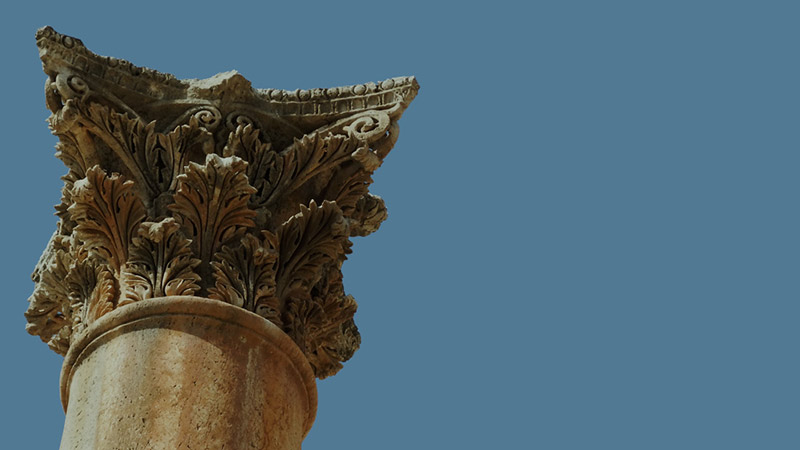You Searched "Cities"
-
Volume 13
Lesson 13.1 | Abraham and Sarah and Three Strangers
PREVIEW VIEW TRAILER
VIEW TRAILERAbraham and Sarah and Three Strangers
32:43 minutes
When the Israelites left Egypt and began their journey with God to the Promised Land, how much did they know of their past history? Some, like Moses' parents, seemed to have retained a knowledge and faith in the God of their fathers, but the Bible... MORELocations:
Negev Desert, Tel Arad, Arad, Israel, Timna valley, Israel, -
Volume 13
Lesson 13.2 | Israel at Sinai: The First Great Commission
PREVIEW VIEW TRAILER
VIEW TRAILERIsrael at Sinai: The First Great Commission
33:29 minutes
In the beginning, God created magnificent beauty and order out of absolute chaos, "tohu vebohu," in Hebrew. When humanity rebelled, the world began a long progression of slipping back into that chaos. Yet God wasn't finished; He decided... MORELocations:
Jordan River, Negev Desert, Timna valley, Israel, Wilderness of Paran, Israel,Tags:
corner, holy, kaddosh, kanaf, laquakh, marry, tallit, tassels, tohu, tzit, vebohu, -
Volume 13
Lesson 13.3 | Jesus Renews His Mission: Seeking the Lost
PREVIEW VIEW TRAILER
VIEW TRAILERJesus Renews His Mission: Seeking the Lost
30:33 minutes
Sheep and shepherds were so much a part of the Biblical world, it's no wonder Jesus uses the imagery as a metaphor in several of His teachings. The shepherds of His day knew every one of the animals in their flock by sight and spent their lives pr... MORE -
Volume 13
Lesson 13.4 | The Lost Son: In a Far Country
PREVIEW VIEW TRAILER
VIEW TRAILERThe Lost Son: In a Far Country
30:55 minutes
Of all the parables Jesus told, the one we call "The Prodigal Son" is possibly the most famous. In the story, a younger son demands his inheritance from his father and leaves the family behind, taking his riches to a far country. The imp... MORELocations:
Gerasa (Jerash), Jordan, Qatzrin, Israel, -
Volume 13
Lesson 13.5 | The Seeking Father: The Lost Son Returns
PREVIEW VIEW TRAILER
VIEW TRAILERThe Seeking Father: The Lost Son Returns
32:00 minutes
Throughout His ministry, Jesus' compassion for sinners and those considered unclean raised the eyebrows of the Pharisees and the teachers of the law. God's word warned His people not to touch any unclean thing, and they could not understand why Je... MORELocations:
Gerasa (Jerash), Jordan, Qatzrin, Israel, -
Volume 7
Lesson 7.1 | Run! The Passion of Elijah
PREVIEW VIEW TRAILER
VIEW TRAILERRun! The Passion of Elijah
00:21:47 minutes
As the gospel of Jesus spread across a Gentile world unfamiliar with the teachings and culture of the Jews, the early church faced an interesting challenge %u2013 meeting different cultures in their own context to demonstrate the redeeming power o... MORELocations:
Aphrodisias, Turkey , -
Volume 7
Lesson 7.2 | Learning to Walk Like Jesus - Paul's Journey to Rome
PREVIEW VIEW TRAILER
VIEW TRAILERLearning to Walk Like Jesus - Paul's Journey to Rome
00:22:46 minutes
After meeting Jesus on the Damascus Road, Paul dedicated the rest of his life to sharing the gospel with anyone and everyone. He soon became one of the major leaders in the early church, focusing much of his effort on reaching out to the Gentiles.... MORELocations:
Antioch of Pisidia, Omrit, Israel, -
Volume 7
Lesson 7.3 | An Unlikely Disciple
PREVIEW VIEW TRAILER
VIEW TRAILERAn Unlikely Disciple
00:22:39 minutes
The apostle Paul was no stranger to the duties of a rabbi, having studied under one of the most famous rabbis in Israel before becoming one himself. He understood exactly what Jesus meant before His ascension, when He commanded the church to go ou... MORELocations:
Galatia, Turkey, Lystra, Turkey, -
Volume 7
Lesson 7.4 | Why Christians Suffer - The Weight of Gethsemane
PREVIEW VIEW TRAILER
VIEW TRAILERWhy Christians Suffer - The Weight of Gethsemane
00:23:16 minutes
Jesus told His disciples that anyone who wished to follow Him would have to take up his own cross. Many of the early believers did just that, willingly following in their rabbi's footsteps even when it meant certain death. Count their cost as you ... MORELocations:
Cappadocia, Turkey,Tags:
Gethsemane, Gat-Shemanim, -
Volume 7
Lesson 7.5 | Don't Forget Us
PREVIEW VIEW TRAILER
VIEW TRAILERDon't Forget Us
00:23:46 minutes
In his letter to the Corinthian church, Paul wrote that the body of Christ is a unit made up of many parts and when one part suffers, the whole body suffers along with it. Are you aware of the suffering of brothers and sisters, both in your own ex... MORELocations:
Cappadocia, Turkey, Derinkuyu, Turkey, - LOAD MORE
- SHOW ALL




























